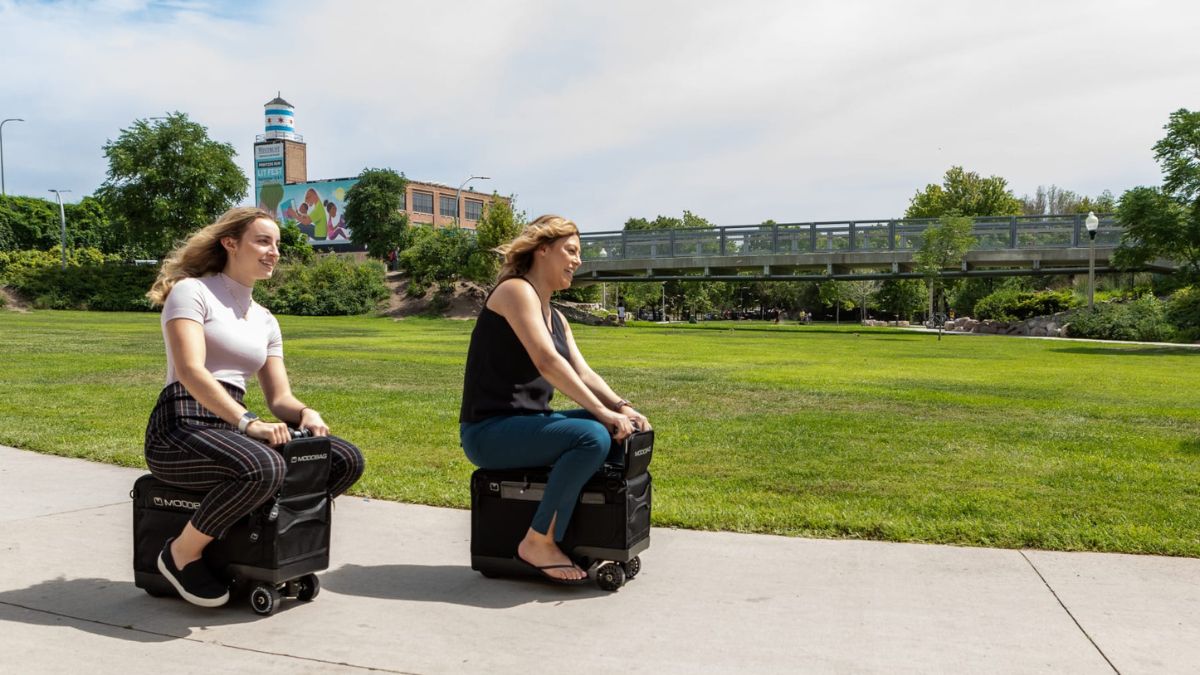As Japan experiences a surge in tourism, thanks to the weakened yen, a new trend has emerged: motorised, rideable suitcases.
These innovative devices, which combine the functionality of a suitcase with the convenience of a scooter, have gained popularity among travellers, especially in major Asian countries. Originally developed in China, celebrities like Paris Hilton and Shilpa Shetty have also contributed to their rising fame.
What does the law in Japan say?
Despite their convenience, electric suitcase scooters have become a legal headache in Japan. According to Japanese traffic laws, these devices are classified as “motorised bicycles,” similar to mopeds.
This categorisation requires users to have a driving license, register the suitcase, equip it with safety features like rearview mirrors and turn signals, and wear helmets. These regulations are in place because the suitcases, powered by lithium-ion batteries, can reach speeds of up to 13 km/hr.
Idkw but this look so cute and cool at the same time, the way she was driving that suitcase so fast with just one hand
— jennie random things (@randomjenniekim) July 7, 2023
pic.twitter.com/oqASzNjHSl
In June, a Chinese woman in her 30s, studying in Japan, was referred to prosecutors for driving without a license after allegedly riding a three-wheeled suitcase on a sidewalk in Osaka. Similarly, in July, a boy from Indonesia was stopped by police for riding a motorised suitcase in Osaka’s bustling Dotonbori shopping district. His family was surprised to learn about the licensing requirements.
Impact Shorts
More ShortsHow have electric suitcase scooters impacted public spaces?
Major Japanese airports have reacted to the increasing use of electric suitcases. Narita Airport near Tokyo, Chubu Centrair International Airport in Aichi Prefecture, and Kansai International Airport in Osaka have advised travelers not to ride these suitcases within their facilities.
Complaints from passengers about the disruption caused by these devices whizzing past them in terminals have prompted these warnings.
Self driving suitcase. pic.twitter.com/8IUW4mcHNQ
— Brian Roemmele (@BrianRoemmele) March 27, 2024
Narita Airport issued an advisory for passengers to be “careful of your surroundings,” while Tokyo’s Haneda Airport banned the use of electric suitcases in February to prevent collisions with other travelers. Singapore’s Changi Airport has taken it a step further by banning these devices entirely.
Is there a need for new classifications?
The growing popularity of electric suitcase scooters has sparked a debate on whether new classifications should be established to regulate them more effectively.
Takeru Shibayama, a senior scientist at the Vienna University of Technology’s Institute for Transportation, told Kyodo News that Japan’s broad range of vehicles under the “motorised bicycles” category might necessitate a discussion on new classifications to accommodate these new mobility devices.
wooyoung driving his suitcase around his hotel room at 10pm at. iggy 😂❤️ pic.twitter.com/XeNXpIqImq
— saba (@yazzsss) July 14, 2024
Japan has also faced challenges with other new forms of transportation. Traffic violations involving electric scooters surged fourfold in the six months following the relaxation of regulations in July 2023. The eased restrictions allow people over 16 to ride them without a driver’s license, making electric scooters a common sight in cities like Tokyo.
How does overtourism come into this?
The post-pandemic boom has led to record numbers of tourists flocking to Japan, drawn by its rich cultural heritage, technological advancements, and scenic beauty.
In March 2024, during the cherry blossom season, Japan welcomed 3.08 million visitors, the highest monthly influx since 1964, according to the Japan National Tourism Organisation (JNTO). In 2023, the country saw a sixfold increase in tourism compared to 2022, with 25.1 million tourists visiting.
While this surge is beneficial for Japan’s economy, generating USD 11.4 billion in the first quarter of 2024 alone, it has also led to significant challenges. Overtourism has caused congestion, pollution, and damage to cultural heritage sites, impacting the quality of life for locals and leading to public resentment.
In cities like Kyoto and at natural landmarks like Mount Fuji, the influx of tourists has resulted in overcrowding and environmental degradation.
How is Japan tackling overtourism?
Japan has implemented several measures to address the issues brought on by overtourism. Kyoto has closed private property alleys in its Geisha district to prevent harassment and inappropriate behaviour by tourists. Violators face fines of up to Yen 10,000.
The city of Hatsukaichi in western Japan has introduced a tourist tax for visitors to Miyajima Island. Tourists must pay a fee of Yen 100. To mitigate crowding on public buses, Japan plans to expand its bus fleet and introduce specific buses for tourists. Kyoto has launched an express bus service connecting the Kyoto Station to popular destinations, available on weekends and holidays.
Ahead of the mountaineering season at Mount Fiji, authorities have implemented a new gate, online booking system, shorter entry window, and higher fee for the Yoshida Trail. Visitors must now pay Yen 2,000 and the number of tourists is capped at 4,000 per day.
Japan has introduced a ‘luggage forwarding’ scheme to ease the burden on transport facilities. Tourists can travel without luggage from Kansai and Narita airports, utilise coin lockers at Tokyo station, and avail of carriage services through the Hands-Free Kyoto campaign.
The Japan Rail Pass prices have been significantly increased to discourage excessive usage. For example, the price for a seven-day pass for regular seats has risen from Yen 29,650 to Yen 50,000. Some Tokyo neighbourhoods have outlawed public drinking. In Shibuya City, public drinking is prohibited from 6pm to 5am starting October.
With inputs from agencies


)

)
)
)
)
)
)
)
)



